
What Factors Should You Consider When Looking for a Reliable Personal Injury Lawyer?
September 12, 2019
3 Types of Damage Related to Negligent Personal Injury Cases
October 7, 2019It may come as a shock to most non-lawyers, but there is no law school course called “personal injury law.” Rather, law students take a course called “tort law” which encompasses all the ways one person can damage another. While the exact mechanism that causes the damage may vary from situation to situation, there are only three theories that personal injury law firms use to establish liability for torts.
1. Intentional torts
Intentional torts are those in which the person committing the tort has a specific intent to take the action that resulted in the damage. Under common law, there are seven intentional torts: battery, assault, intentional infliction of emotional distress, false imprisonment, trespass to land, trespass to chattels, and conversion.
To prove an intentional tort, the damaged party must prove that the tortfeasor acted with specific intent and that the action caused damage.
Thus, a person who was injured by a chair thrown during a fight could have a claim for battery. The chair thrower intended to throw the chair and the thrown chair resulted in an injury.
One characteristic of intentional torts is that the damaged party need only prove that the tortious action caused the damage; he or she does not need to prove that the damage was foreseeable. Thus, if the thrown chair hits a lamp and the lamp falls and electrocutes the damaged party, causation is established even though electrocution might not be a foreseeable consequence of throwing a chair.
Another characteristic of intentional torts is the broad scope of damages. Specifically, damages for intentional torts may include compensatory damages and exemplary damages, also called punitive damages.
Personal injury law firms will often allege intentional torts, if possible, because of the lower requirements for proving causation and the possibility of recovering exemplary damages.
2. Negligence
Negligence is the bread and butter of personal injury law firms. Intent is difficult to prove in many cases, such as in the 54% of personal injury cases that involve auto accidents. It can be difficult or impossible to know if a driver intentionally rear-ended another driver as a result of road rage or negligently as a result of inattention.
To prove negligence, an accident lawyer must prove that the injured party was owed a duty of care, the duty was not met, the failure to meet that duty caused the accident, and the accident resulted in damage. Thus, in an auto accident caused by texting while driving, the distracted driver owed other drivers the duty to drive attentively and the distracted driver breached that duty by texting while driving. Assuming the accident was caused by the distraction and resulted in damages, the negligence case is proven.
Personal injury law firms will often allege both intentional torts and negligence in the same case. This gives a judge or jury the option of selecting a legal theory that fits the circumstances.
In a case where a pedestrian is struck by tools that fell from a scaffolding, a personal injury law firm may allege that the construction workers intentionally pushed or threw the tools attempting to harm someone and also that the construction workers were negligent in securing the tools so they would not accidentally fall from the scaffolding.
3. Strict Liability
Strict liability applies to certain types of activities in which the mindset of the potential defendant is difficult to discern or the activities are so dangerous the potential defendant is liable for any harm caused by the activity.
One example of strict liability accompanies ultra-hazardous activities, such as working with explosives or storing toxic waste. In these cases, the party engaging in the ultra-hazardous activity will be held liable for any harm, even though the party did not intentionally or negligently cause the harm. Thus, if homes are damaged when a building is demolished, the demolition company may be liable regardless of the care it exercised in avoiding possible damage.
Another example of strict liability is product liability. In these cases, it is often impossible to prove the mindset of the product designers and manufacturers. Thus, these cases typically only require proof of a defect and proof of causation.
Personal injury claims may take the form of intentional torts, negligence, or strict liability. A personal injury law firm can advise you on which may be applicable to your case.





